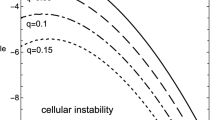Abstract
A stochastic model of chemical reaction-heat conduction-diffusion for a one-dimensional gaseous system under Dirichlet or zero-fluxes boundary conditions is proposed in this paper. Based on this model, we extend the theory of the broadening exponent of critical fluctuations to cover the chemical reaction-heat conduction coupling systems as an asymptotic property of the corresponding Markovian master equation (ME), and establish a valid stochastic thermodynamics for such systems. As an illustration, the non-isothermal and inhomogeneous Schlögl model is explicitly studied. Through an order analysis of the contributions from both the drift and diffusion to the evolution of the probability distribution in the corresponding Fokker-Planck equation(FPE) in the approach to bifurcation, we have identified the critical transition rule for the broadening exponent of the fluctuations due to the coupling between chemical reaction and heat conduction. It turns out that the dissipation induced by the critical fluctuations reaches a deterministic level, leading to a thermodynamic effect on the nonequilibrium physico-chemical processes.
Similar content being viewed by others
References
Luo J, Zhao N. From Local Equilibrium Thermodynamics to Stochastic Thermodynamics. Chengdu: Sichuan Science and Technology Press, 2004. 110–127, 128–143, 163–177
Luo J. Fluctuations around nonequilibrium steady states of electrochemical reaction systems and concentration polarization: A formalism of stochastic thermodynamics of concentration polarization. J Chem Phys, 1997, 106: 3587–3591
Luo J. Dissipations and polarizations in irreversible electrode processes: A unite formalism of stochastic thermodynamics of both concentration polarization and activation polarization. J Chem Phys, 1999, 110: 4937–4943
Zhao N, Luo J. Entropy and entropy production of finite chemical reaction systems influenced by Gaussian noise. J Chem Phys, 2001, 114: 7761–7770
Zhao N, Luo J. Polarization induced by external noise in irreversible electrode processes: A stochastic measure of thermodynamic effects driven by external noise in electro-chemical reaction systems. J Chem Phys, 2002, 116: 5807–5813
Luo J, Zhao N, Hu B. Effects of critical fluctuations to stochastic thermodynamic behavior of chemical reaction systems at steady state far from equilibrium. Phys Chem Chem Phys, 2002, 4: 4149–4154
Xiao T, Ma J, Hou Z, Xin H. Effects of internal noise in mesoscopic chemical systems near Hopf bifurcation. New J Phys, 2007, 9: 1–12
Xin H, Hou Z. Internal noise stochastic resonance in a circadian clock system. J Chem Phy, 2003, 119: 11508–11512
Zhang W, Xu J, Luo J. Symmetry breaking of temperature field in spatially distributed systems induced by chemical reaction-diffusion-heat conduction couplings. Chem J Chinese Univ, 2004, 25: 488–492
Nicolis G, Malek Masour M. Onset of spatial correlations in nonequilibrium syatems: A master-equation description. Phys Rev, 1984, 29: 2845–2853
Baras F., Malek Mansour M, Van den Broeck C. Asymptotic properties of coupled nonlinear Langevin equations in the limit of weak noise. II: Transition to a limit cycle. J Stat Phys, 1982, 28: 577–587
Malek Masour M, Van Den Broeck C, Nicolis G, Turner J W. Asymptotic behavior of Markovian Master equation. AnnPhys, 1981, 131: 283–313
Lin F, Zhao N, Luo J. Local non-equilibrium fluctuation, internal noise and dissipation in gaseous heat conduction systems with high values of prantl number. Chin Chem Lett, accepted
Fan Y, Zhong D, Luo J. Torus-like chemical oscillation induced by heat conduction-diffusion coupling between chemical reaction system characteristic of multi-steady states transition and related environment. Chem J Chinese Univ, 2006, 27: 2344–2348
Lin F. Fluctuation, transition an dissitation in nonequilibrium chemical reaction systems. Ph.D. Dissertation. Chengdu: Sichuan University, 2010. 45–60
Author information
Authors and Affiliations
Corresponding authors
Rights and permissions
About this article
Cite this article
Lin, F., Zhao, N. & Luo, J. A critical transition rule for broadening exponent of fluctuation and its effect on dissipation in chemical reaction-heat conduction coupling systems. Sci. China Chem. 54, 774–781 (2011). https://doi.org/10.1007/s11426-011-4254-6
Received:
Accepted:
Published:
Issue Date:
DOI: https://doi.org/10.1007/s11426-011-4254-6



